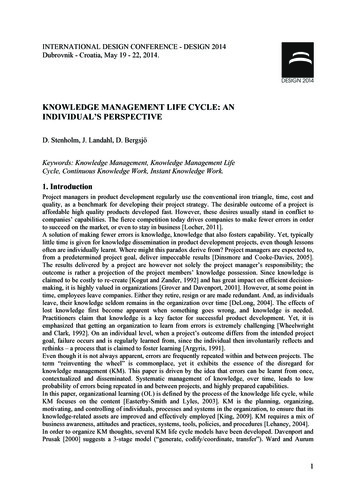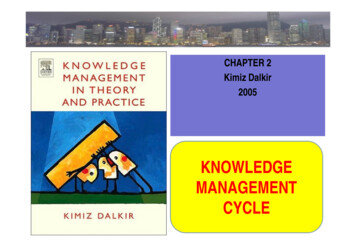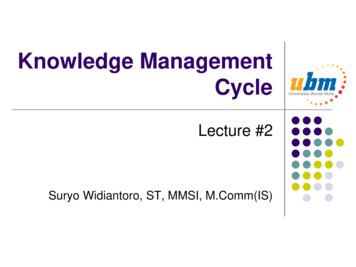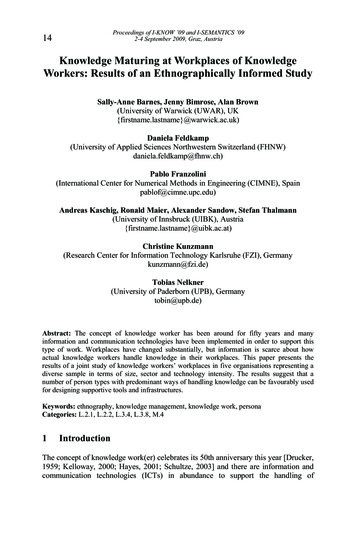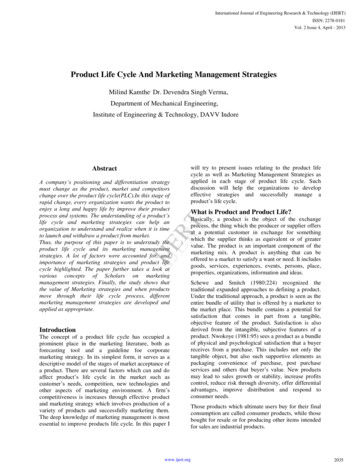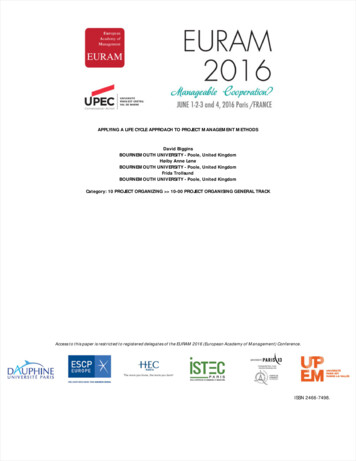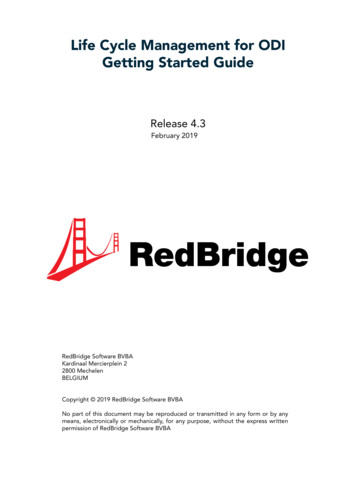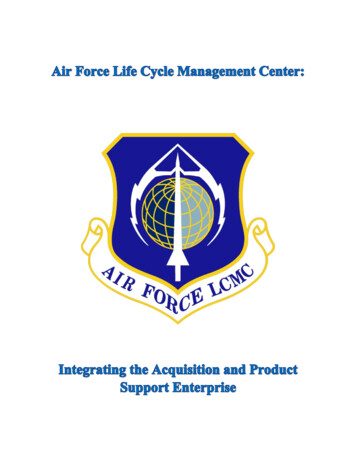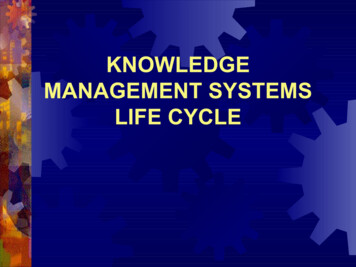
Transcription
KNOWLEDGEMANAGEMENT SYSTEMSLIFE CYCLE
Chapter 3: Knowledge Management Systems Life CycleMain Topics of This Lecture Challenges Compare User’s Stagesin building KM SystemsCSLC and KMSLCvs. Expert’s Characteristicsof KMSLC2-2
Chapter 3: Knowledge Management Systems Life CycleCHALLENGES IN BUILDING KMSYSTEMS Culture— getting people to share knowledge Knowledgeevaluation— assessing the worth of knowledgeacross the firm Knowledgeprocessing— documenting how decisions arereached Knowledgeimplementation— organizing knowledge and integratingit with the processing strategy for finaldeployment2-3
Chapter 3: Knowledge Management Systems Life CycleConventionalSystem Life CycleversusKM SystemLife CycleRecognition of Need andFeasibility StudyEvaluate ExistingInfrastructureSoftware RequirementsSpecificationsForm the KM TeamLogical Design (masterdesign plan)IterativeKnowledge CaptureDesign KMS BlueprintPhysical Design (coding)Verify and validate the KMSystemTestingIterativeImplementation (fileconversion, user training)Operations and MaintenanceImplement the KM SystemManage Change andRewards StructurePost-system evaluation2-4
Chapter 3: Knowledge Management Systems Life CycleKey Differences Systems analysts deal with information from theuser; knowledge developers deal withknowledge from domain experts Users know the problem but not the solution;domain experts know both the problem and thesolution System development is primarily sequential;sequentialKMSLC is incremental and interactive.interactive System testing normally at end of conventionalsystem life cycle; KM system testing evolvesfrom beginning of the cycle2-5
Chapter 3: Knowledge Management Systems Life CycleKey Differences (cont’d) Conventionalsystem lifecycle is process-driven“specify then build”; KMSLCis result-oriented“start slow and grow”2-6
Chapter 3: Knowledge Management Systems Life CycleKey SimilaritiesBoth begin with a problem andend with a solution Both begin with informationgathering or knowledge capture Testing is essentially the sameto make sure the system is rightand it is the right system Both developers must choosethe appropriate tool(s) fordesigning their respectivesystems 2-7
Chapter 3: Knowledge Management Systems Life CycleStages of KMSLCEvaluate ExistingInfrastructureForm the KM TeamKnowledge CaptureDesign KM BlueprintIterative Rapid PrototypingVerify and validate the KMSystemImplement the KM SystemManage Change andRewards StructurePost-system evaluation2-8
Chapter 3: Knowledge Management Systems Life Cycle(1) Evaluate ExistingInfrastructureSystem justifications: What knowledge will be lostthrough retirement, transfer, ordeparture to other firms? Is the proposed KM systemneeded in several locations? Are experts available andwilling to help in building a KMsystem? Does the problem in questionrequire years of experienceand tacit reasoning to solve?2-9
Chapter 3: Knowledge Management Systems Life CycleThe Scope Factor Consider breadth and depthof the project withinfinancial, human resource,and operational constraints Project must be completedquickly enough for users toforesee its benefits Check to see how currenttechnology will matchtechnical requirements ofthe proposed KM system2-10
Chapter 3: Knowledge Management Systems Life CycleRole of Strategic Planning Riskyto plunge into a KMS without strategyKnowledge developer should consider: Vision — Foresee what the business is trying toachieve, how it will be done, and how the newsystem will achieve goals Resources — Check on the affordability of thebusiness to invest in a new KM system Culture — Is the company’s political and socialenvironment amenable to adopting a new KM2-11system?
Chapter 3: Knowledge Management Systems Life Cycle(2) Form the KM TeamIdentify the key stakeholdersof the prospective KMsystem. Team success depends on: Ability of team members Team size Complexity of the project Leadership and teammotivation Not promising more thancan be realisticallydelivered 2-12
Chapter 3: Knowledge Management Systems Life Cycle(3) Knowledge Capture Explicitknowledgecaptured in repositoriesfrom various media Tacit knowledge capturedfrom company expertsusing various tools andmethodologies Knowledge developerscapture knowledge fromexperts in order to build theknowledge base2-13
Chapter 3: Knowledge Management Systems Life CycleSelecting an Expert How does one know theexpert is in fact an expert? How would one know thatthe expert will stay with theproject? What backup should beavailable in case theproject loses the expert? How could we know what isand what is not within theexpert’s area of expertise?2-14
Chapter 3: Knowledge Management Systems Life CycleRole of the KnowledgeDeveloper Thearchitect of the system Job requires excellentcommunication skills, knowledgeof capture tools, conceptualthinking, and a personality thatmotivates people Close contacts with the champion Rapport with top management forongoing support2-15
Chapter 3: Knowledge Management Systems Life Cycle(4) Design the KM BlueprintThe KM blueprint addressesseveral issues: Finalize scope of proposed KMsystem with realized netbenefits Decide on required systemcomponents Develop the key layers of theKM software architecture tomeet company requirements System interoperability andscalability with existingcompany IT infrastructure2-16
Chapter 3: Knowledge Management Systems Life Cycle(5)Testing the KM System Verificationprocedure:ensures that the systemhas the right functions Validationprocedure:ensures that the systemhas the right output Validationof KMsystems is notfoolproof2-17
Chapter 3: Knowledge Management Systems Life Cycle(6) Implement the KM SystemConverting a new KM system into actualoperation This phase includes conversion of data or files This phase also includes user training Quality assurance is important, which includeschecking for: Reasoning errors Ambiguity Incompleteness False representation (false positive and falsenegative) 2-18
Chapter 3: Knowledge Management Systems Life Cycle(7) Manage Change andRewards Structure Goalis to minimizeresistance to change Experts Regularemployees(users) Troublemakers Resistancesviaprojection, avoidance,or aggression2-19
Chapter 3: Knowledge Management Systems Life Cycle(8) Post-system Evaluation Assesssystem impact in terms of effectson: People Procedures Performance of the business Areasof concern: Quality of decision making Attitude of end users Costs of Knowledge processing and update2-20
Chapter 3: Knowledge Management Systems Life CycleKey Questions Hasaccuracy and timeliness of decisionmaking improved? HasKMS caused organizational changes? Whatare users’ reactions towards KMS? HasKMS changed the cost of operatingthe business? Haverelationships among users affected? DoesKMS justify the cost of investment?2-21
Chapter 3: Knowledge Management Systems Life CycleEnd of Lecture 22-22
Chapter 3: Knowledge Management Systems Life Cycle PurposeStatement of Scope & Objectives2.1 System functions2.2 Users and characteristics2.3 Operating environment2.4 User environment2.5 Design/implementation constraints2.6 Assumptions and dependencies3. Functional Requirements3.1 User interfaces3.2 Hardware interfaces3.3 Software interfaces3.4 Communication protocols and interfaces4. Nonfunctional Requirements4.1 Performance requirements4.2 Safety requirements4.3 Security requirements4.4 Software quality attributes4.5 Project documentation4.6 User documentation2-23
Chapter 3: Knowledge Management Systems Life CycleUsers Versus ExpertsAttributeDependence on systemCooperationUserHighUsually cooperativeExpertLow to nilCooperation notrequiredTolerance for ambiguity LowHighKnowledge of problemHighAverage/lowContribution to systemInformationKnowledge/expertiseSystem userYesNoAvailability for systembuilderReadily availableNot readily available2-24
Chapter 3: Knowledge Management Systems Life CycleRapid Prototyping Process?Structurethe ProblemReformulate rea TaskBuilda TaskRepeatedCycle(s)2-25
Chapter 3: Knowledge Management Systems Life Cycle.Layers of KM Architecture123User Interface(Web browser software installed on each user’s PC)Authorized access control(e.g., security, passwords, firewalls, authentication)Collaborative intelligence and filtering(intelligent agents, network mining, customization, personalization)Knowledge-enabling applications4(customized applications, skills directories, videoconferencing, decision support systems,5(e-mail, Internet/Web site, TCP/IP protocol to manage traffic flow)6(specialized software for network management, security, etc.)group decision support systems tools)TransportMiddlewareThe Physical Layer(repositories, cables)7DatabasesLegacy applications(e.g., payroll)Groupware(document exchange,collaboration)Data warehousing(data cleansing,data mining)2-26
Chapter 3: Knowledge Management Systems Life CycleKnowledge Capture andTransfer Through TeamsTeam performsa specialized taskOutcomeAchievedFeedbackKnowledgestored in aform usable byothers in theorganizationEvaluate relationshipbetween action Developer2-27
2-5 Chapter 3: Knowledge Management Systems Life Cycle Key Differences Systems analysts deal with information from the user; knowledge developers deal with knowledge from domain experts Users know the problem but not the solution; domain experts know both the problem and the solution System development is pr

